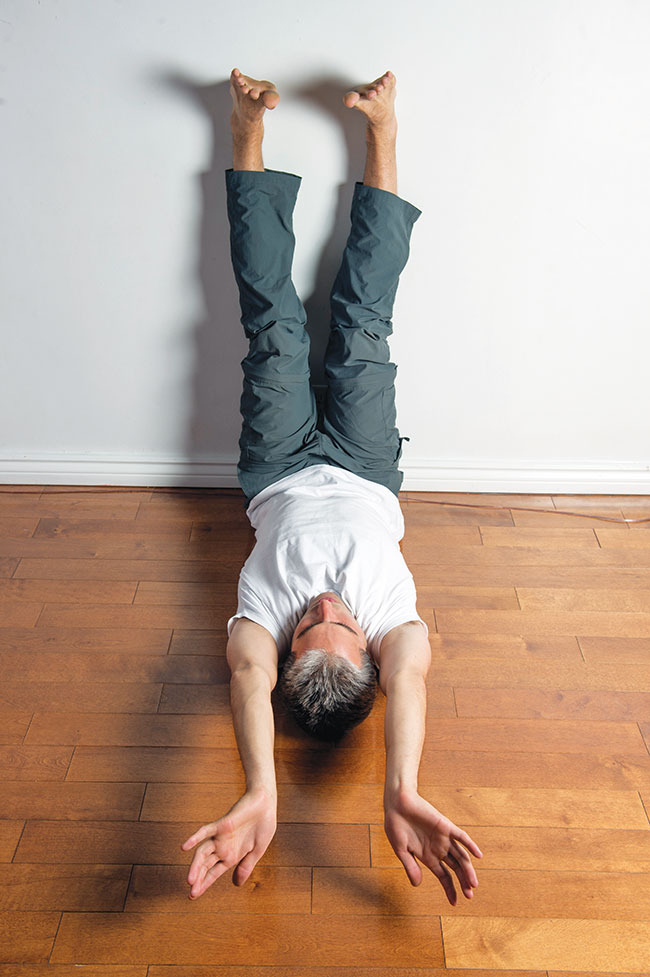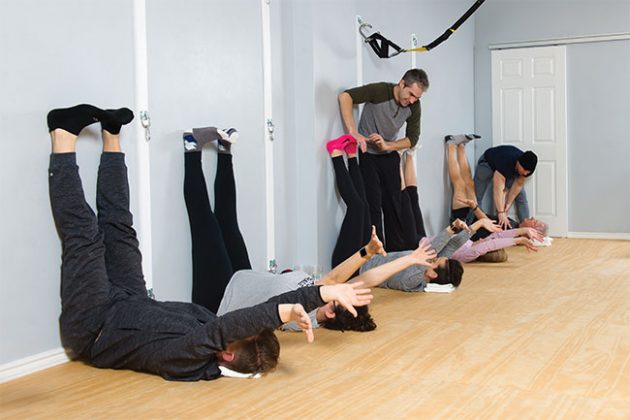
Keeping at-the-ready
By Sean Waldie and Micheal Okumura
Features fitnessELDOA exercises can help maintain your body’s optimal range of motion.
 Here is an example of a stretch to reduce back pain. Photos: Sean Waldie
Here is an example of a stretch to reduce back pain. Photos: Sean Waldie In the fire service, keeping equipment in its ready state is a must. It is important to check and re-check gear to ensure it’s able to meet the demands of the job when it’s go-time.
The nature of the work and the demands of the job, whether it be from physical training or actual on-duty work, can cause a variety of wear and tear related issues to the body that can compromise physical readiness for action.
There were some interesting research statistics in a 2017 study titled Firefighter Injuries Relative to Fire Response Characteristics and published by the University of the Fraser Valley in British Columbia and Lakehead University in Thunder Bay. The study used the National Fire Information Database (NFID) and examined 2,025 professional firefighters who sustained an injury and reported it to the NFID. Here are some of the highlights.
- The most frequently reported injury type was injury to muscle, ligaments, and joints (45 per cent) with injury location being the head, neck or spine (11 per cent).
- The 2,025 injured firefighters had an average of 14 years of service experience. The majority were middle aged (31-45 years) and older (46 years) males with a body mass index of 27.3 kg/m2.
- More than 80 per cent of injuries reported were categorized as minor (injuries requiring less than one day off work and/or in hospital). Less than 20 per cent were categorized as serious (injuries requiring 16 or more days off work and/or hospitalization for three or more days).
Obviously, it’s easy to know when we’ve sustained a more serious injury, but speaking from professional experiences as a manual osteopath and rehabilitation exercise trainer, it’s often a culmination of a number of aches, pains and strains that are the breeding ground for more significant issues.

When you do your ELDOA exercise, you are creating space not just at the bone and joint but also at the muscle. It is this change in the structure of the muscle that helps to maintain the improved function of the target area.
Photos: Sean Waldie
How does an individual know if he or she has a ligament issue?
If you find that you have either sharp pain or dull aching pain when you’re at rest but the pain dissipates after you exercise or when your body is active, that suggests it is ligament-related. Just because it is not present when active, doesn’t mean it is getting better or gone away. The physical activity has simply created a temporary support due to the muscles being engaged. That is why when you return to the resting state that ache or sharp pain returns.
Although those somewhat mundane pains such as radiating in the hips or the intense stiffness in the back can, at times, simply be ignored, that can only go on for so long. What may be subtly occurring in the body is that muscle has become trapped in a shortened position that, while somewhat functional, is painful and irritated. It means you start moving a little slower and awkwardly, maybe not enough to notice immediately, but the body has begun a complex process of learning to live with less-then-optimal range of motion and flexibility.
How do you remedy wear and tear related injuries?
The ELDOA method, which is a French acronym that when translated into English means LOADS or longitudinal osteoarticular decoaptation stretching, is a series of decompression stretches. There are hundreds of specific ELDOAs a person can learn for individual joints, specific muscles or groups of muscles. Many professional athletes and sports teams have started to incorporate the practice of ELDOA to help with recovery, performance and injury prevention.
The reason ELDOA is being used by other peak performers is that the exercises are precise at increasing space in the body. It’s with millimetres that great miles are achieved.
If we have healthy ranges of movement, our body can move without restriction, hesitation or complaint. When these millimetres of movement decrease, we begin to lose large degrees of movement and then pain and discomfort can show its signs.
People often embrace ELDOA for its ability to diminish pain that spikes during activities, pain or discomfort after specific positions (sitting or standing for long periods) and pain while they are at rest.
In addition to restoring optimal ranges of motions, ELDOA has another important goal: to re-condition connective tissue (fascia) to be elastic. It is our connective tissue that creates the casing around muscles, giving them the room to move freely.
When you do your ELDOA exercise, you are creating space not just at the bone and joint but also at the muscle. It is this change in the structure of the muscle that helps to maintain the improved function of the target area.
Over the last several months, our studio has extended a free trial of ELDOA to the members of the Toronto Professional Fire Fighters’ Association. Upon feedback from these members, our team has prepared an instructional manual of several positions that we feel are the best positions to begin your practice with. You can receive this free document by simply emailing either sean@kempwaldie.com or the front desk of Fusion Health Studio at marcemokumura@gmail.com.
Sean Waldie is a manual osteopath and movement specialist at Fusion Personal Health Studio in Toronto. He can be reached at sean@kempwaldie.com. Micheal Okumura is the owner of Fusion Personal Health Studio. Reach him at mo@fusionhealthstudio.com.
Print this page